Montana is home to various spiders, each with its own story and role in the ecosystem. These eight-legged creatures are often misunderstood, but a closer look can help us appreciate their important work.
The Big Sky Country’s spider population is fascinating, from black widows to house spiders. This article will explore the different spider species in Montana, including their unique characteristics and behaviors. We’ll cover everything from web-spinning spiders and orb-weavers to hunting spiders like wolf and jumping spiders.
- Related article: Spot Wildlife in Montana
Ever wonder how spiders in the state contribute to keeping the insect population in check? Or how do you tell the difference between a harmless spider and a potentially dangerous one? Our guide to Montana spiders will provide insights and tips that might just change how you see these arachnids.
7 Key Takeaways on Montana’s Spiders
- Spiders in Montana have unique biological features. These include four pairs of legs, spinnerets for silk production, and a two-part body, setting them apart from other insects.
- Spiders in Montana help control insect populations without posing significant risks to humans.
- Spider management in Montana focuses on coexisting with these arachnids. It only intervenes when a real threat exists, such as venomous species like black widows.
- Identifying spiders is essential for effective pest control and prompt medical treatment in case of bites. This is especially true for venomous species like the black widow and hobo spider.
- Montana is home to various web-spinning spiders, from orb-weavers creating intricate webs to funnel web spiders with unique web designs.
- Not all spiders found in Montana are dangerous. Understanding their characteristics is crucial for distinguishing venomous from non-venomous species.
- Wolf spiders are known for their hunting abilities and unique reproduction methods. They are common in Montana and play a significant role in the state’s ecosystems.
General Overview of Spiders in Montana
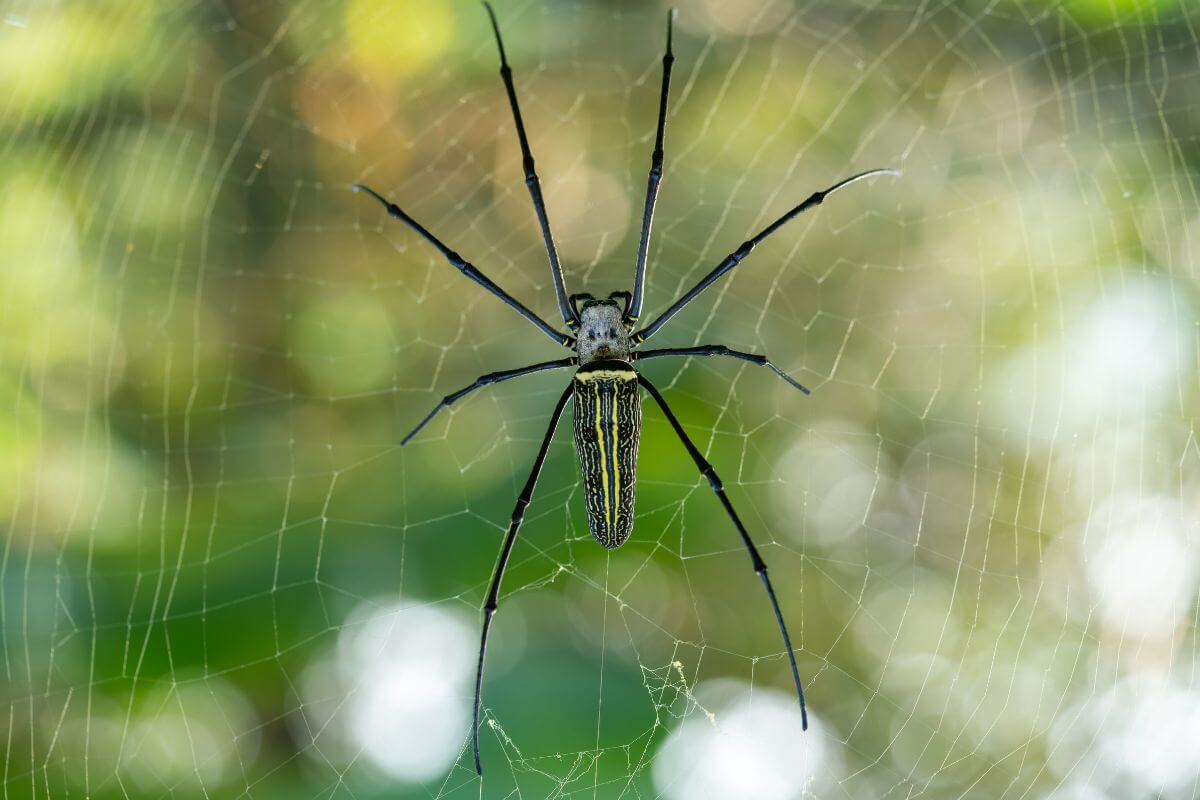
Spiders are vital to Montana’s ecosystems, from the tiny jumping spiders to the larger orb-weavers. Let’s learn more about them.
Biology of Spiders in Montana
Spiders are a special kind of creature in Montana’s vast natural tapestry. They stand out from insects in a few key ways. Here’s how spiders compare to other insects:
| Characteristic | Spiders | Insects |
|---|---|---|
| Body Segments | Spiders have two main body parts: cephalothorax (the head and thorax combined) and abdomen. | Insects have three main body parts: head, thorax, and abdomen. |
| Legs | Spiders have four pairs of legs. | Insects have three pairs of legs. |
| Wings | Spiders typically do not have wings. | Many insects have wings for flight. |
| Antennae | Spiders lack antennas. | Most insects have antennae. |
| Diet | Spiders are predatory, feeding on other insects and arthropods. This diet helps keep the insect population in check. | Insects eat a bit of everything, from plants to your garbage. |
Fascinating facts about spiders in Montana:
- Spinnerets – These are small silk-spinning organs at the back of a spider’s abdomen. When a spider creates its web, it’s the spinnerets doing all the work. This silk is incredibly strong and has many uses beyond just webs.
- Size – In the spider world, females are usually larger than males. Both have an extra pair of leg-like parts near their head called pedipalps. These are handy for lots of things, including mating.
- Mouthparts – Spiders have chelicerae, which are tiny pincers near their mouths. These pincers are connected to poison glands. Most spiders use venom to paralyze their prey, making it easier to eat. Don’t worry, only a few spiders in Montana have venom.
Spiders in Montana are more than just weavers of intricate webs. They are nature’s pest controllers, with a unique biology that sets them apart from other critters.
Montana Spider Management

Spiders are often unwelcome guests in our homes, but we look at them differently in nature-loving Montana. We understand their role as natural pest controllers. Spiders eat insects, and they do it well. This means fewer bugs bothering us.
Here are a couple of ways to handle spiders in your home in Montana:
- Use a broom or a vacuum to move the spider outside or crush it. Take note that crushing spiders should be a last resort. A gentle sweep with a broom can relocate them. This way, you keep your home spider-free without causing harm.
- Keep areas around your home clear of clutter and debris. This makes it less inviting for spiders looking for a home. Some spots spiders love around houses include corners and under eaves.
We usually let spiders do their job. We only step in when there’s a real danger, like with black widows. These spiders have venom that can be harmful, so we use caution. When we talk about managing spiders, we’re talking about finding a balance between nature and comfort.
Montana Spider Identification
Identifying spiders is as important as knowing poisonous snakes and plants. This skill is crucial for many, including county agents and health officials in Montana. They need to be able to spot the two truly poisonous spiders in the state: the black widow and the hobo spider.
The brown recluse is another venomous spider. Even though it hasn’t been positively identified in Montana, it’s essential to understand its features to rule it out during spider checks.
When trying to identify spiders in Montana, it is usually helpful to focus on the following physical traits:
- Eyes – The number of eyes a spider has and how they are arranged helps in identifying them.
- Body – The shape and size of the spider.
- Legs – The length of the spider’s legs and any distinctive markings on it also help you tell it apart.
- Spinnerets – Spinnerets are the structures spiders use to spin webs. The presence of these parts tells you whether the spider is a web spinner.
Among others, these details are what experts use to group spiders. If someone gets bitten and needs medical help, positively identifying the spider is a huge help. It can aid in providing the right treatment and even be life-saving in some cases.
Web Spinning Spiders in Montana
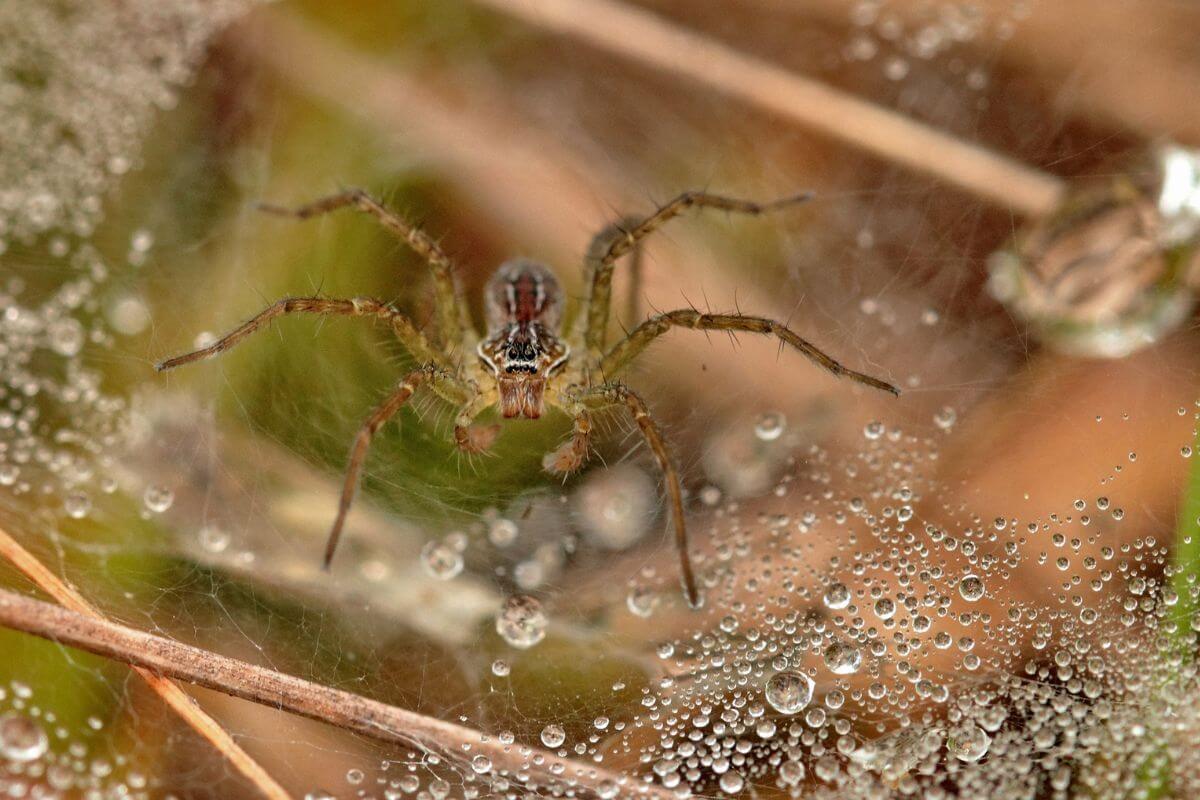
Montana is home to a fascinating array of spiders, many of which are skilled web spinners. These eight-legged artists create intricate webs that serve as both homes and hunting grounds.
Let’s examine the variety of web-spinning spiders across the state, from the classic orb weavers to the funnel weavers that hide in plain sight.
1. Black Widow Spiders
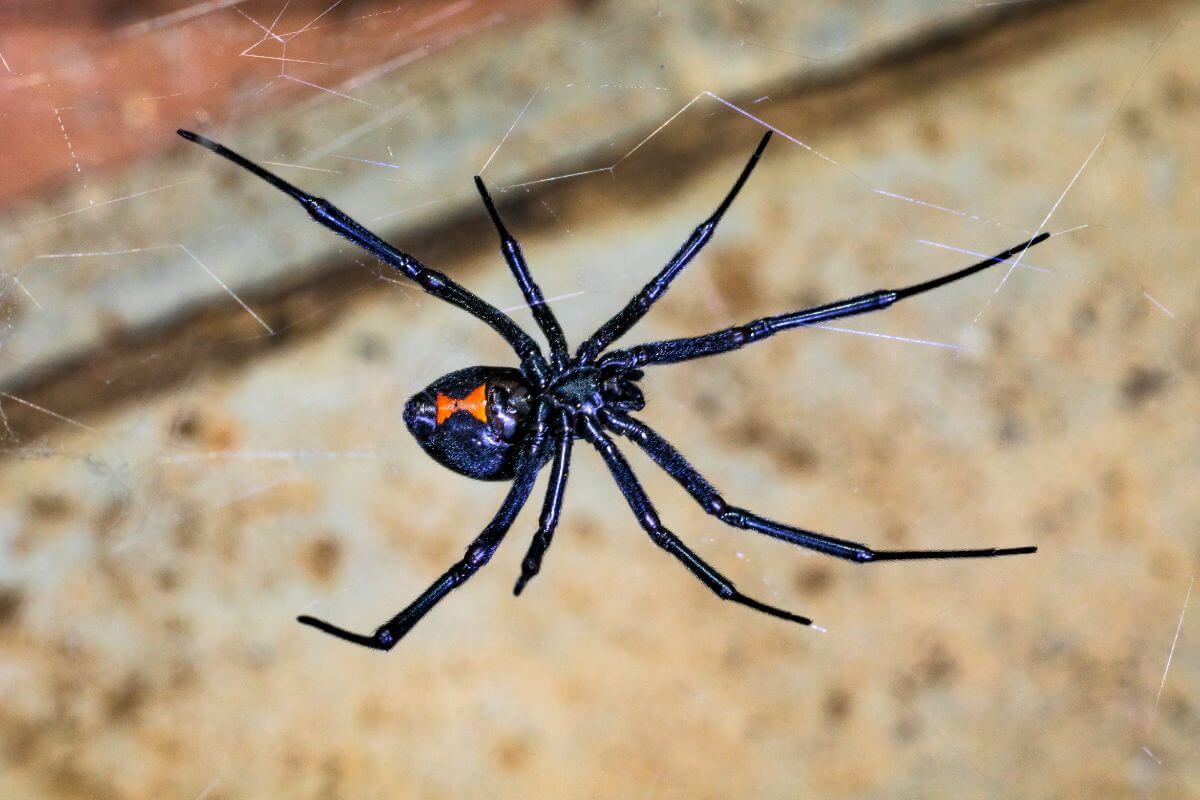
Black widow spiders are famous for a chilling reason: the females often eat the males after mating. This practice is not unique to black widows but has become the spider’s signature. The name “black widow” reflects this deadly post-mating behavior.
Montana has two main species of black widow spiders: the northern black widow (Latrodectus various) and the western black widow (Latrodectus hesperus). They are recognized by their distinctive hourglass shape on the underside of their abdomens. This marking, usually red or orange, stands out.
Key characteristics that help us distinguish between the Western Black Widow and the Northern Black Widow:
| Characteristic | Western Black Widow | Northern Black Widow |
|---|---|---|
| Female Body Size | The female Western Black Widow’s body size is about half an inch long. | The female Northern Black Widow’s body size resembles the Western Black Widow’s. |
| Male Body Size | The male Western Black Widow’s body size is less than half that of females. | The male Northern Black Widow’s body size resembles the Western Black Widow’s. |
| Female Abdomen Markings | The female Western Black Widow has a complete hourglass marking on the underside, usually black, with a small reddish spot near the tip. | The female Northern Black Widow has an incomplete hourglass marking or splits into 2 triangles, usually black, with a row of reddish spots along the top and diagonal whitish bands on each side. |
| Male Color | Male Western Black Widows are light brown. | Female Northern Black Widows are generally black. |
| Male Abdomen Markings | Male Western Black Widows have three diagonal pale stripes on each side. | Female Northern Black Widows have four diagonal whitish bands on each side. |
Both species of spiders have venom that affects the nervous system and causes intense pain. The pain is not immediate at the bite site but spreads to the abdomen and limbs. This venom can lead to serious symptoms like accelerated heartbeat, breathing problems, and even paralysis.
In rare cases when a black widow bite is fatal, the cause is usually suffocation. Seeking medical help is crucial if bitten, as there are antidotes available.
Encountering a black widow in Montana is a serious matter. But with the right knowledge, it doesn’t have to be a scary one.
2. House Spiders
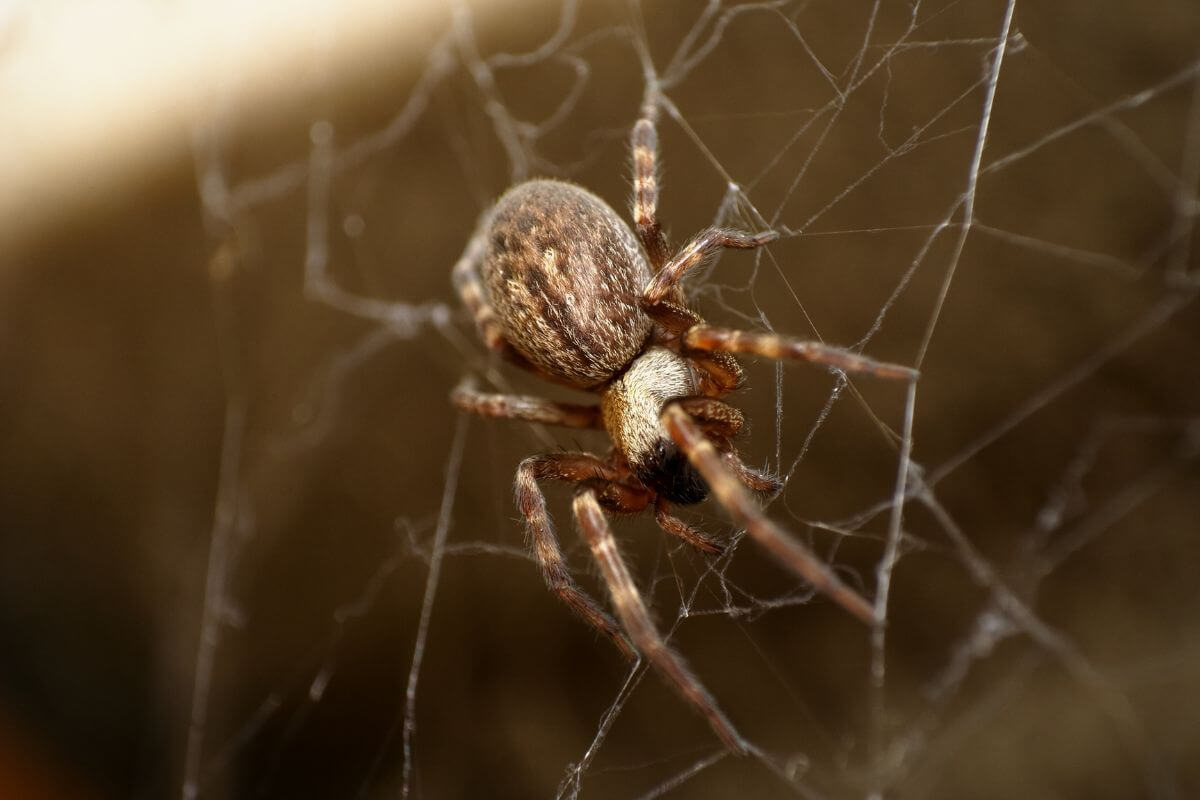
House Spiders, also known as Comb-footed Spiders, belong to the Family Theridiidae. These are the spiders you often see in buildings. These arachnids are special because two of their side eyes touch each other and are far from the other four eyes.
These spiders are medium to small-sized, with shiny bodies and round abdomens. The female house spider is usually 1/8 to 3/8 inches long. Its abdomen, which can look like it has chevron patterns, is covered in dusty white or brownish hairs.
House spiders make messy webs in quiet spots around your home, like in corners or under furniture. You’ll find bits of dead bugs stuck in or under their webs, showing they’re good at catching food. Unlike black widow spiders, house spiders don’t mind sharing their webs with other house spiders.
Some house spiders look a lot like black widows but without the poison. That’s because they come from the safe family as black widows, Genus Steatoda.
Adult female Steatoda spiders look similar in size and shape to black widows but are missing the red hourglass marking under their abdomen. Instead, they might have a whitish T-shape on their abdomen. This is how you can tell them apart and know they’re not dangerous.
3. Orb-Weaver Spiders
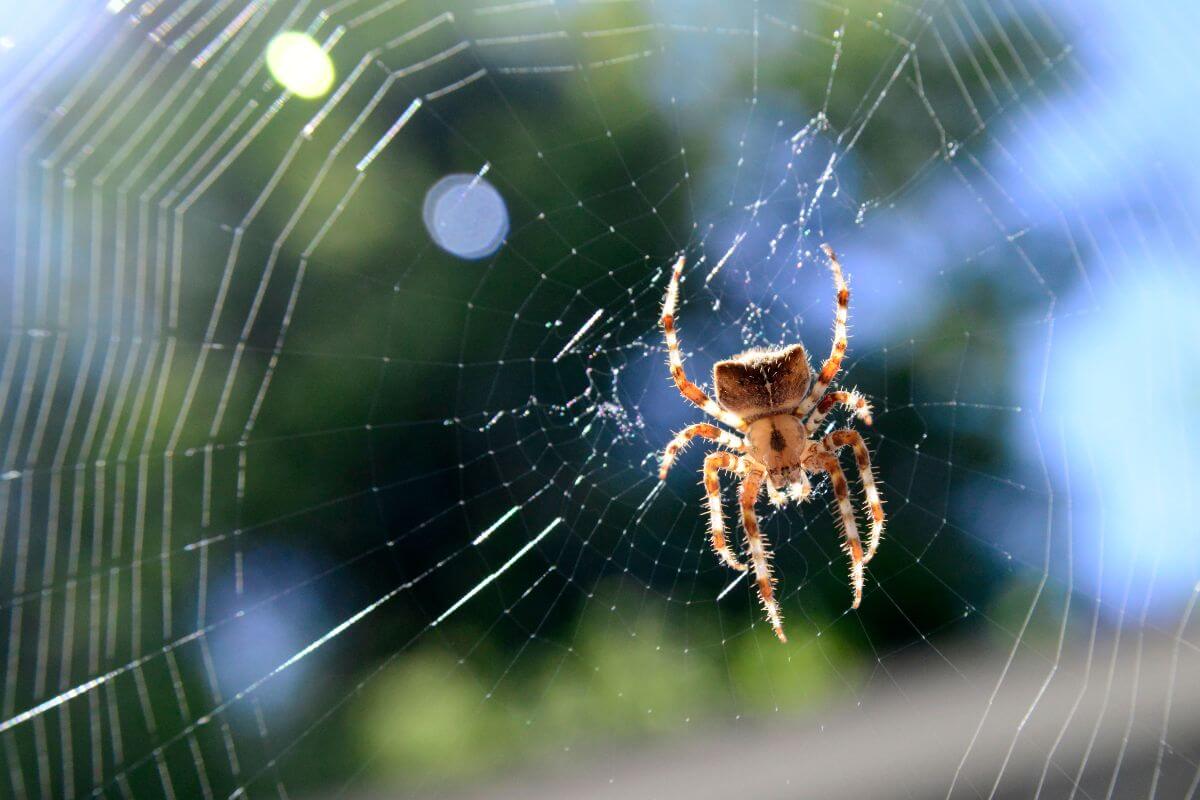
Orb-Weaver Spiders stand out in Montana’s spider population with their stout, spiny legs and small, grouped eyes. These garden spiders are not only large, with bodies ranging from 1/2 to 1 inch, but they also sport eye-catching markings of black, white, yellow, or orange.
It is common to encounter orb-weavers in Montana in late summer or fall. These skilled and memorable orb-weaver spiders create intricate orb webs in less than an hour. The female orb-weaver takes center stage in this web, ever alert to the vibrations that signal a catch.
Their reproductive strategy is just as fascinating. After mating, the female orb-weaver carefully selects a protected spot to lay her eggs. Imagine a cluster of 300 to 800 eggs, safeguarded through the winter to hatch in the spring.
This cycle of life and the efficiency with which orb-weavers build their webs are remarkable and offer a glimpse into the intricate world of Montana’s spiders.
4. Funnel Web Spiders
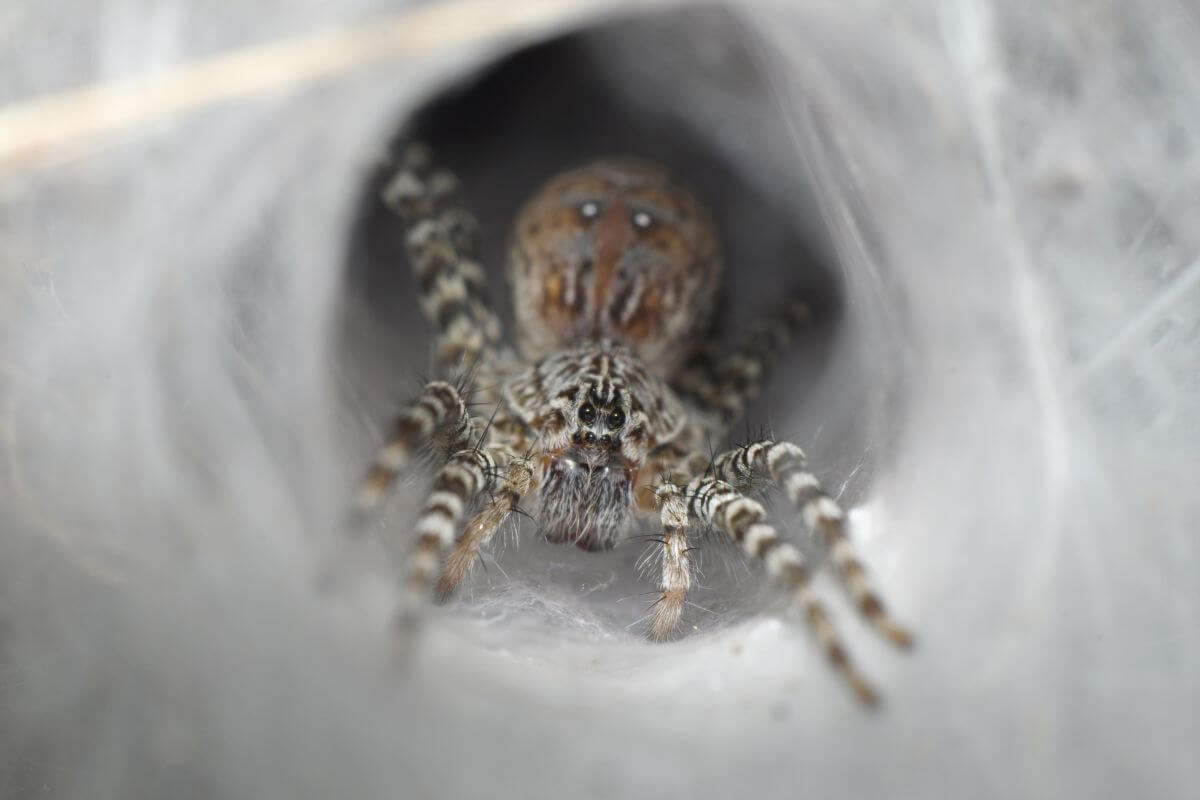
Funnel Web Spiders belong to the Family Agelenidae and are architects of sheet-like webs. These spiders are known for their long, two-segmented spinnerets and small, sub-equal eyes arranged in neat rows.
What makes funnel web spiders unique?
- Physical Features – Funnel Web Spiders all sport 8 eyes of similar size. Their bodies are around 1/2 inch long and adorned with dark stripes on a grayish cephalothorax. But the standout feature? Their elongated posterior spinnerets are essential for web spinning.
- Web Construction – Funnel Web Spiders’ webs are not just any webs, they are flat and extend into tubes or funnels. These intricate webs are commonly found in places like shrubbery near buildings or the nooks of windows and doors.
- Life Cycle and Habits – Funnel Web Spiders are most abundant in late summer and fall when they might venture into our homes. However, with the arrival of frost, many perish, leaving their offspring protected in eggs to hatch in the spring.
It is common to encounter these spiders, especially as they seek shelter from the cold. Their presence near buildings is a natural part of their lifecycle and a testament to their adaptability.
Montana Spiders That Don’t Spin Webs
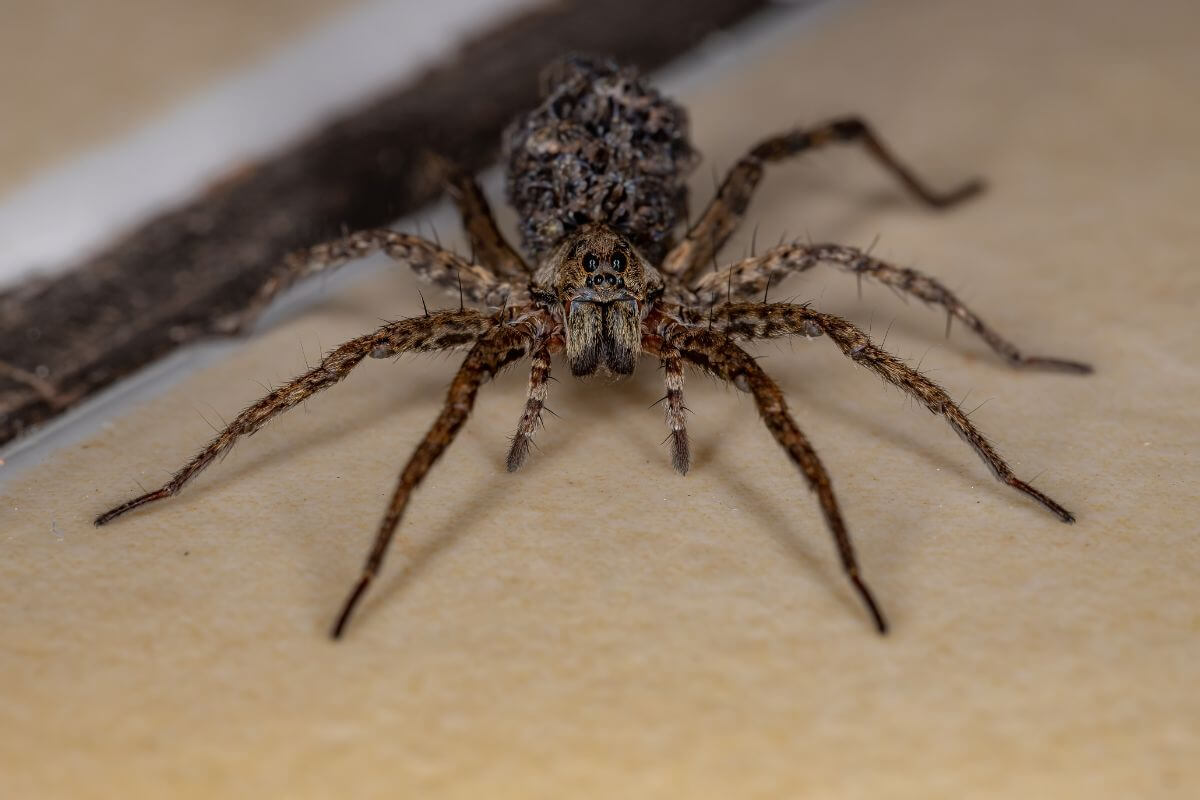
Montana is home to a variety of spiders, and some of them are relatively unique because they don’t spin webs. These spiders have developed different ways to catch their prey, making them stand out in the world of arachnids.
Let’s look at these fascinating creatures and how they survive in Montana’s diverse landscapes.
1. Brown Recluse Spiders
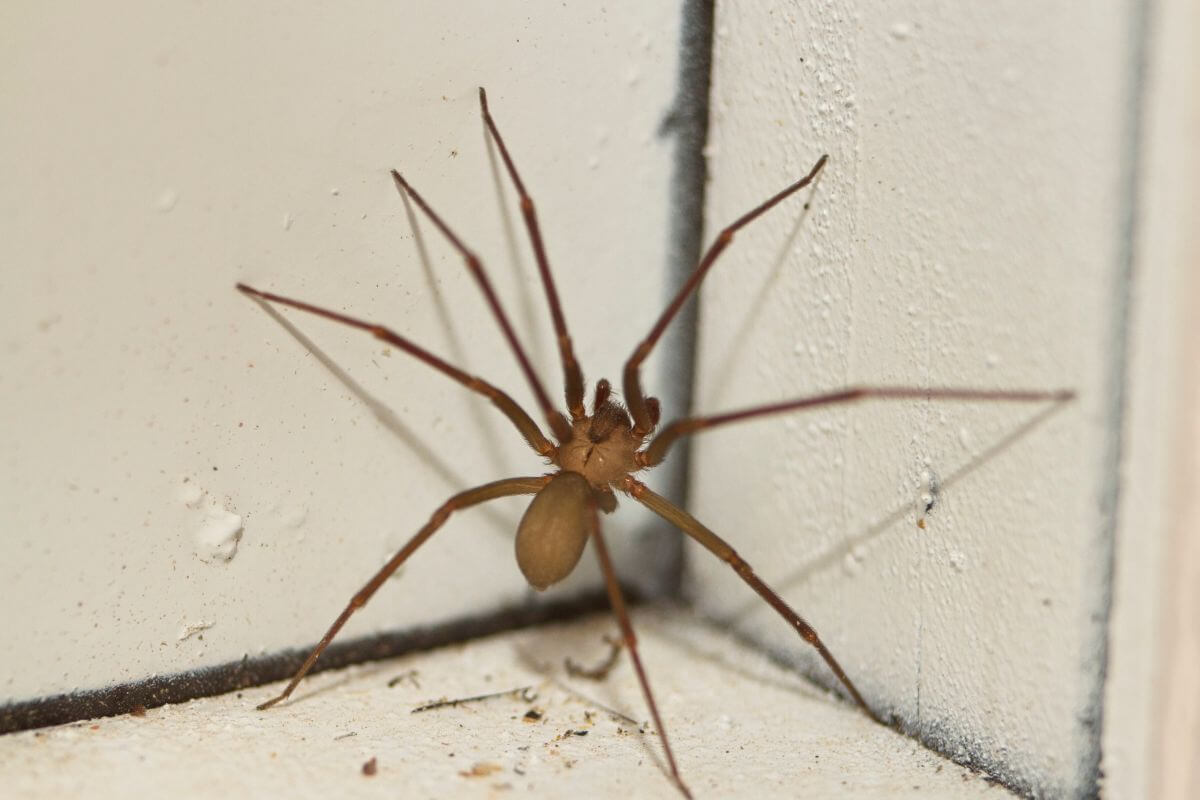
Brown Recluse Spiders are important to learn about despite never having been positively identified in Montana. They belong to the Loxoscelidae family. Understanding their features helps quickly identify them, even though other spider bites might be mistaken for theirs.
Distinct Characteristics of Brown Recluse Spiders:
- Unique Markings – Brown Recluse Spiders have a dark, violin-shaped mark on their tan cephalothorax.
- Distinct Eye Arrangement – Brown Recluse Spiders’ six eyes are arranged in three pairs, forming a semicircle. This differs from most spiders, which have eight eyes in various arrangements.
Both male and female brown recluse spiders are venomous, and their bites can cause various reactions. Reactions to their bites can vary among individuals but commonly include:
- Immediate stinging followed by intense pain
- Development of a small blister
- Swelling and congestion around the bite
While brown recluse spider bites are usually not deadly, they can lead to slow-healing, necrotic wounds and scars. Physicians sometimes mistake similar reactions from other spider bites as brown recluse bites. This misdiagnosis can affect the treatment and healing process of the actual spider bite.
2. Wolf Spiders
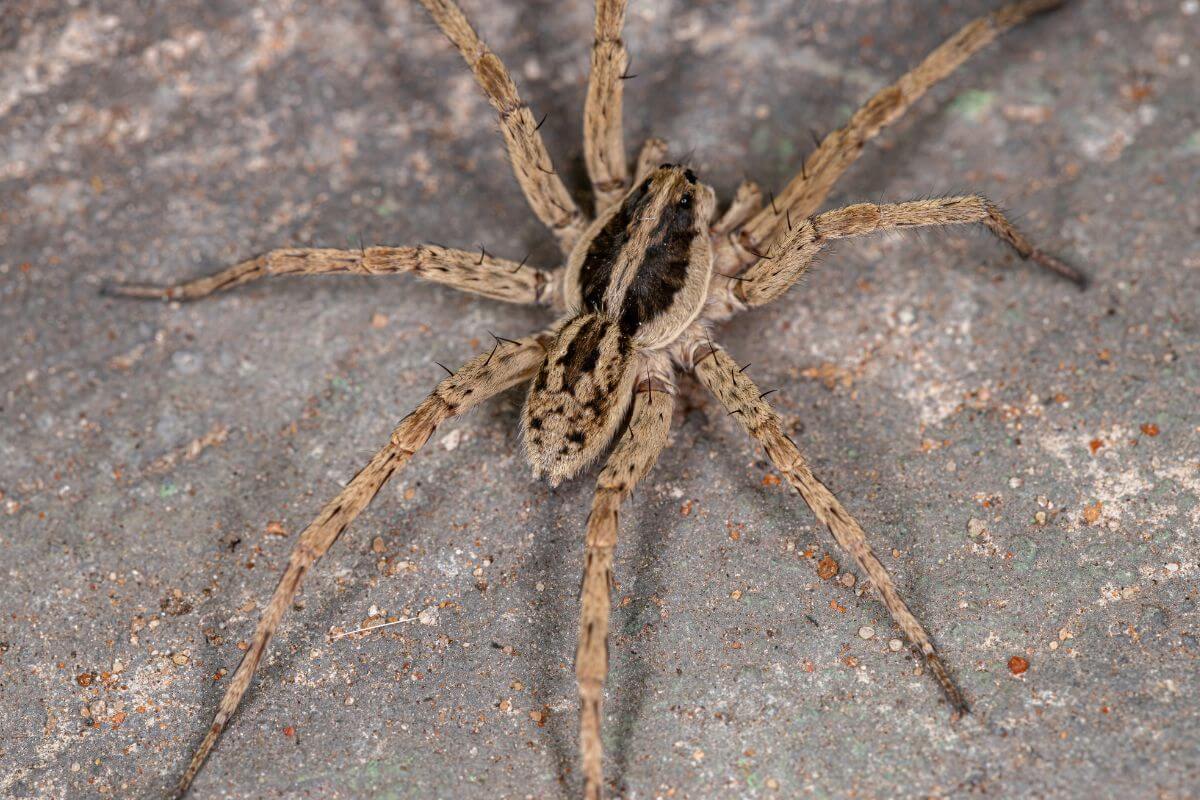
Wolf Spiders are known for their hunting prowess, belonging to a family of hunter spiders – the Family Lycosidae. They are the embodiment of agility and keen eyesight.
Here are some characteristics that set wolf spiders apart as top predators:
- Eyesight – The eyes of Wolf Spiders are uniquely arranged in three rows, with four large eyes at the top and a front row of four small eyes. This design gives them excellent vision, perfect for chasing and catching prey.
- Size and Color – Wolf spiders are medium to large, often hairy, and predominantly brown or black. Their color and hairy bodies help them blend into their surroundings, while their long legs are built for speed.
- Mobility and Reproduction – Unlike many spiders, wolf spiders do not spin webs to catch food. Females carry their egg sacs with them, and once the spiderlings hatch, they ride on their mother’s back. This unique behavior ensures the young are protected and mobile.
Encountering wolf spiders in Montana can be quite the experience. Some of the largest spiders in the state are part of this family. Their mobility means they are not restricted to a particular habitat and are known to venture into homes during the fall, driven by the hunt for prey.
3. Jumping Spiders
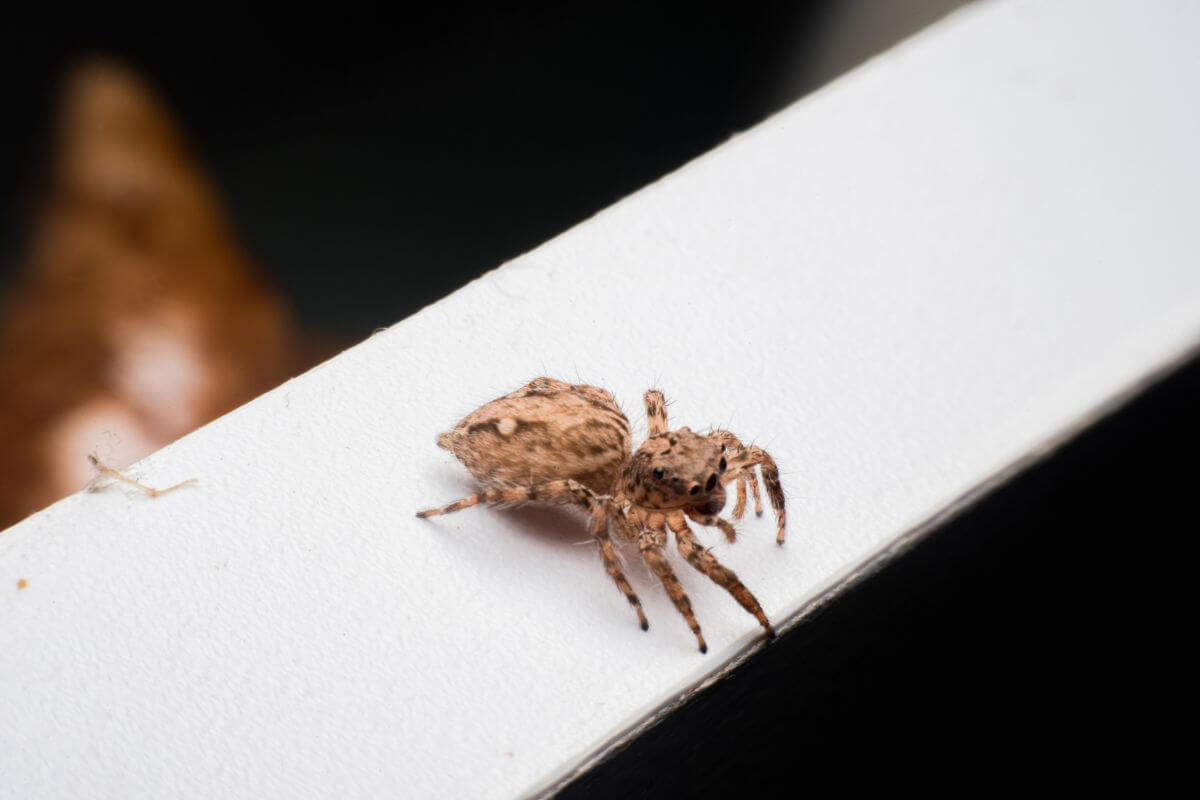
Jumping Spiders are from the Family Salticidae, known for their agility and unique features. They are typically small to medium-sized, with stout, hairy bodies and short legs. You’ll often notice them by their distinctive black, reddish, or yellowish markings.
Jumping spider facts:
- Appearance and Nature – Jumping Spiders have a square-fronted cephalothorax with four large anterior eyes. Their legs are usually short and stout, with the first pair sometimes enlarged. They have a diurnal nature, meaning they are active during the day.
- Agility and Hunting – Jumping Spiders are agile predators that hunt by pouncing on their prey. They eat small insects and are often found near homes, particularly on screens, doors, or windows. Unlike other spider species, Jumping Spiders don’t rely on webs to catch their meals.
Encountering a jumping spider can offer a glimpse into the intricate world of arachnids. Their presence near living spaces is a natural form of pest control, as they help manage insect populations.
4. Crab Spiders

Crab Spiders, also known as Ambush Spiders, belong to the Thomisidae family. These spiders earned their name because they look and move like crabs and can walk sideways or backward. They are medium-sized and come in vibrant colors, with wide abdomens at the back.
Unique characteristics of crab spiders:
- When you look at a Crab Spider, you’ll notice that the first two pairs of legs are longer and stronger than the back two. They use these front legs to catch their prey.
- With eight small, light-colored eyes, Crab Spiders have great vision.
- Crab spiders are often found in gardens, where they can be seen on flowers and plants. They don’t make webs but hunt for their prey or hide on blossoms and other parts of plants. They can also change their colors to blend in with flowers, which helps them avoid being seen.
So, look closely at the flowers next time you’re in a garden. You might spot a Crab Spider, perfectly camouflaged and waiting for its next meal.
Common Spider Species in Montana
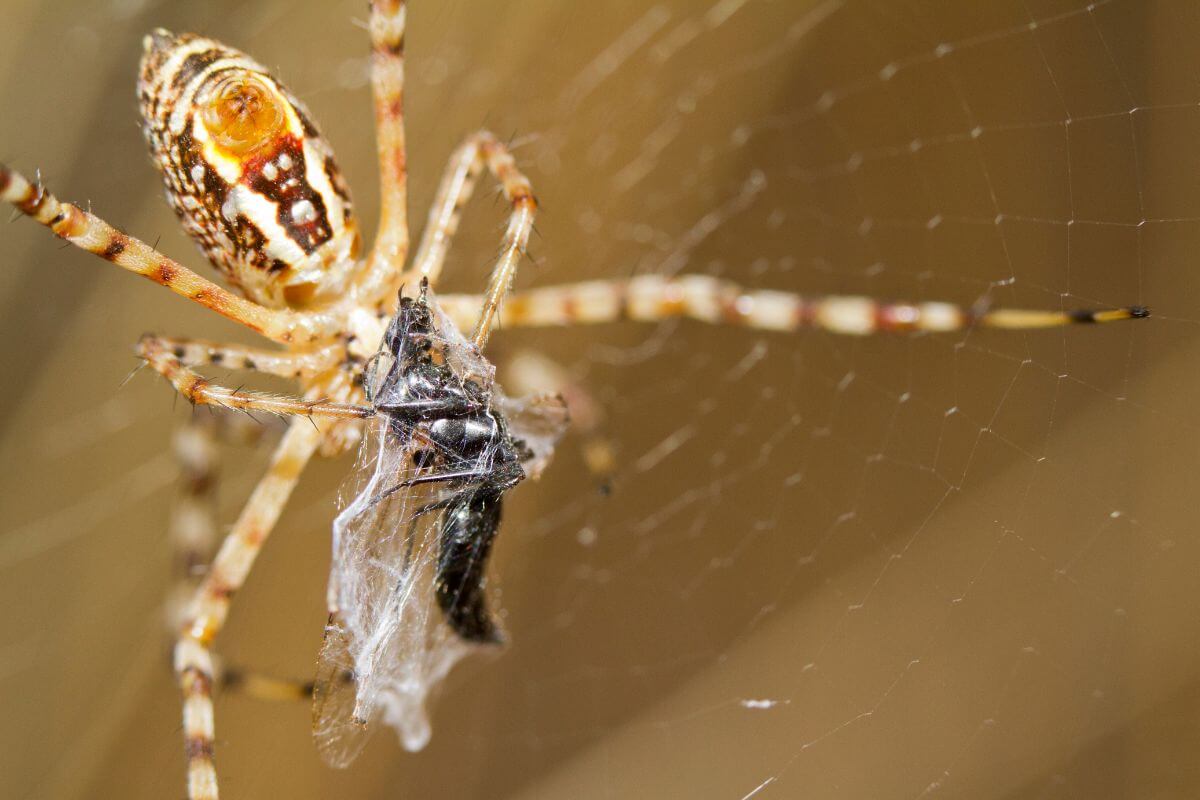
Montana is home to a variety of spiders, each with its unique characteristics and habits. Knowing about these common spider species can help you better understand and appreciate the nature around you.
Meet some of the spiders you might encounter in Montana:
- American Grass Spider (Agelenopsis agelenopsis) – American Grass Spiders are a genus of spiders that can be found almost everywhere, including all U.S. states. They are known to be some of the quickest spiders in the country.
- Arrow-Head Spider (Verrucosa arenata) – Arrow-Head Spiders are orb-weaver spiders found throughout the country. The common name arrowhead spider comes from the triangle-shaped mark on their abdomen.
- Banded Garden Spider (Argiope trifasciata) – The Banded Garden Spider is a common type of Argiope orb-weaving spider found worldwide. It originated in North America.
- Black and Yellow Garden Spider (Argiope aurantia) – The Black and Yellow Garden Spider is easily recognized by its black and yellow abdomen and patterned web.
- Bowl and Doily Spider (Frontinella pyramitela) – The Bowl and Doily Spider is recognized for its unique webs, which are shaped like bowls.
- Candy-Striped Spider (Enoplognatha ovata) – The Candy-Striped Spider is a visually stunning species that doesn’t threaten humans or pets.
- Common House Spider (Parasteatoda tepidariorum) – True to its name, the Common House Spider is a frequent guest in homes, building webs in quiet spots.
- Daring Jumping Spider (Phidippus audax) – The Daring Jumping Spider is known for its bold and adventurous jumps that allow it to cover distances up to 50 times its body length.
- Deadly Ground Crab Spider (Xysticus funestus) – The Deadly Ground Crab Spider is not harmful to humans despite its ominous name. It hunts on the ground for small insects.
- Eastern Parson Spider (Herpyllus ecclesiasticus) – The Eastern Parson Spider gets its name from the clergy-like markings on its back.
- False Black Widow Spider (Steatoda grossa) – Although the False Black Widow Spider or Cupboard Spider resembles the more dangerous black widow, it is less of a threat to humans.
- Fishing Spider (Dolomedes) – The Fishing Spider is a semi-aquatic genus of spiders that prey on insects near water.
- Flower Crab Spider (Misumena) – The Flower Crab Spider is a genus of spiders that hunt for prey in or around flowers. One example of this type of spider is the Golden Rod Crab Spider, which can change color.
- Furrow Spider (Larinioides cornutus) – Although commonly found close to buildings, the Furrow Spider is harmless to humans.
- Hobo Spider (Eratigena agrestis) – The Hobo Spider, known as the aggressive house spider, got its nickname from a mistranslation of its scientific name.
- Leaf-Curling Sac Spider (Clubiona) – The Leaf-Curling Sac Spider is a genus of spider recognized by its light-brown color and sometimes translucent appearance.
- Mouse Spider (Scotophaeus blackwalli) – The Mouse spider is an interesting ground spider with a velvet-like abdomen.
- Northern Yellow Sac Spider (Cheiracanthium mildei) – One of the most common spiders in Northeastern America, the Northern Yellow Sac Spider has a yellow-tan abdomen.
- Red-backed jumping Spider (Phidippus johnsoni) – The red abdomen and black body easily identify the Red-Backed Jumping Spider.
- Running Crab Spider (Philodromus) – Running Crab Spider is a genus of crab spiders with different types throughout the Northern Hemisphere and the United States.
- Spitting Spider (Scytodes thoracica) – The Spitting Spider is a type of hunting spider that uses venomous silk to “spit” at its prey, immobilizing it.
- Starbellied Orb Weaver (Acanthepeira stellata) – The Starbellied Orb Weaver’s spiked abdomen sets it apart, making it a visually interesting species.
- Triangulate Cobweb Spider (Steatoda triangulosa) – The Triangulate Cobweb Spider is a brown-black spider with a unique triangle shape on its back. It is commonly found throughout the United States.
- Zebra Spider (Salticus scenicus) – The Zebra Spider is named for its black-and-white abdomen.
Encountering spiders in Montana is a regular part of nature. Most of them are harmless and play a vital role in the ecosystem. If you find one of these common species, take a moment to observe and appreciate the diversity of life around you.
Montana Spiders Final Thoughts
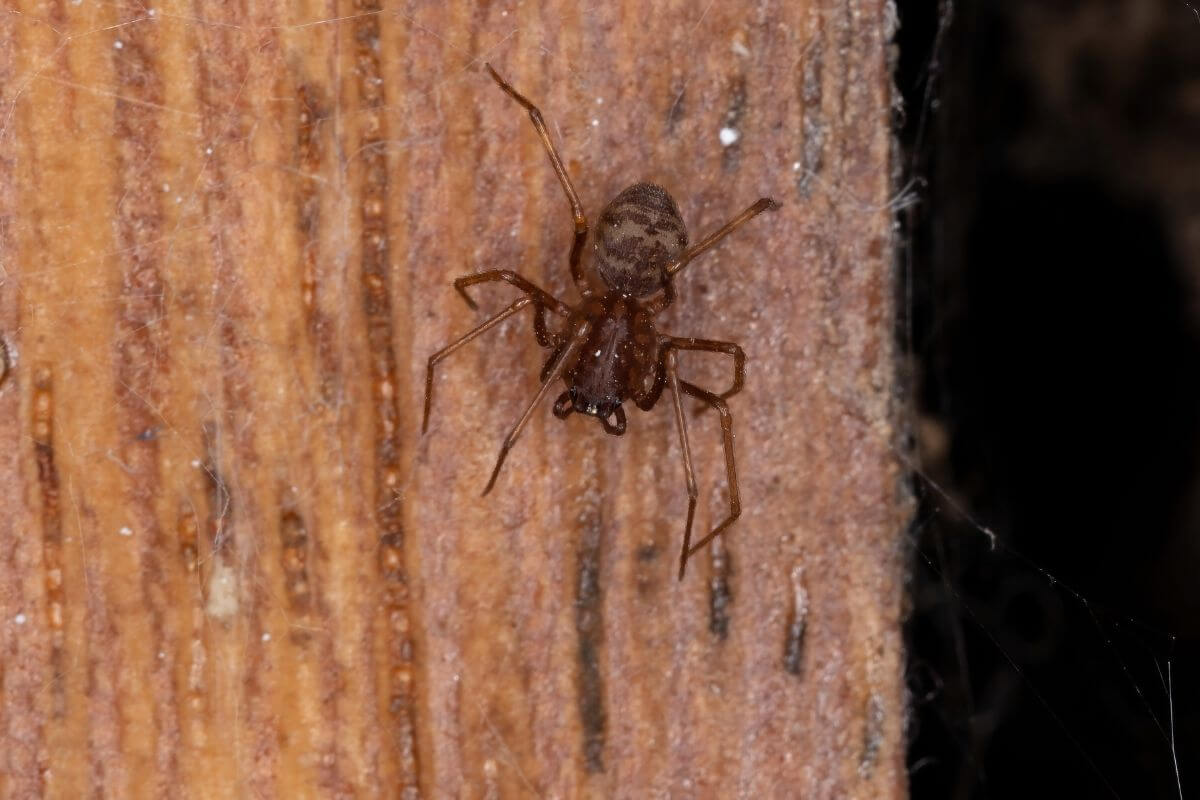
Montana’s spiders are more than just arachnids, they’re essential to the state’s natural balance by keeping insect populations in check. They hold unique features like spinnerets for silk production and a diverse population that includes web spinners and hunters.
The spider management approach in Montana involves respecting nature’s course and intervening only when necessary. This is especially true with venomous species like the Black Widow. Identifying spiders, particularly dangerous ones, is highlighted as a key skill for effective pest control and quick medical response.
As we reflect on Montana’s misunderstood spiders, we now see their crucial role in maintaining the state’s beautiful landscapes and ensuring a harmonious coexistence with nature.
Each spider species brings unique contributions, from the intricate webs of orb-weavers to the hunting techniques of wolf spiders. Let’s do our best to preserve them.
Montana Spiders FAQs
1. Are There Poisonous Spiders in Montana?
Montana has a few species of venomous spiders, including the black widow and hobo spider. While encounters with these spiders are relatively rare, it’s important to be cautious and aware of their presence, especially in areas where they may be found, such as woodpiles, sheds, and other dark locations.
2. What Are the Biggest Spiders in Montana?
In Montana, the biggest spiders are typical wolf spiders (family Lycosidae) and fishing spiders (family Pisauridae). While not as large as some tropical species, these spiders can have body lengths of up to 1 inch (2.5 centimeters) or more, depending on the species.
3. Are Hobo Spiders Common in Montana?
Hobo spiders (Eratigena agrestis) are relatively common in Montana, particularly in urban and suburban areas. They are often found in and around human habitats, such as houses, sheds, garages, and other structures.
4. Are Wolf Spiders Native to Montana?
Wolf spiders (family Lycosidae) are native to Montana. They are found throughout North America, including various habitats in Montana, such as grasslands, forests, and urban areas.
5. How Big Do Wolf Spiders Get in Montana?
In Montana, wolf spiders can vary in size depending on the species, but they typically have body lengths ranging from about 0.5 to 1 inch (1.3 to 2.5 centimeters). Some larger species may have body lengths approaching 1.5 inches (3.8 centimeters) or more.
Learn more about Montana’s diverse wonders through these compelling reads:
- Learn About Montana’s Rattlesnakes
- Squirrels of Montana
- Montana’s Wildlife Refuges
- Montana’s Winter Animals
- About Owls in Montana
- https://www.montana.edu/extension/flathead/documents/ag/spiders-insects/Spider%20Identification%20and%20Management%20MSU%20Montguide.pdf
- https://www.montana.edu/extension/ipm/documents/entomology/ent-fact-sheets-2020-2021/urban_alert_hobo_spiders_2021_ada_compliant.pdf
- https://www.montana.edu/extension/ipm/entomology/resources/fact-sheets/hobo-spiders.html
- https://www.montana.edu/news/15173/msu-extension-s-schutter-diagnostic-lab-answers-questions-about-montana-spiders

